Information
Landmark: Fort Saint-MichelCity: Port de Paix
Country: Haiti
Continent: North America
Fort Saint-Michel is a significant historical site located in Haiti, specifically in the northern region of the country. Here are some key details about this fort:
Historical Context
Fort Saint-Michel was built during the French colonial era in the 18th century. It was part of a series of fortifications designed to protect the French colony of Saint-Domingue (modern-day Haiti) from external threats, particularly from the British and Spanish. The fort was located in the region of Saint-Michel de l'Atalaye, a strategically important area, helping to control key access points to the northwestern part of the island.
Architecture and Design
The fort was constructed with military engineering principles typical of the period. It was designed to withstand attacks and to serve as a stronghold in case of invasion. The architecture reflected the European military styles of the time, featuring stone walls, bastions, and strategic placements for artillery to defend against naval or land-based attacks.
Role in Haitian History
Fort Saint-Michel played a role in the resistance against foreign colonial powers. As a part of the broader network of fortifications in Saint-Domingue, it was used during the Haitian Revolution (1791–1804), a period of intense conflict between enslaved Africans, French colonial forces, and other foreign powers. The Haitian Revolution led to the eventual independence of Haiti in 1804, and Fort Saint-Michel was part of the struggle that led to the abolition of slavery and the creation of the first independent black republic.
Decline and Current Status
Over time, Fort Saint-Michel, like many colonial forts, fell into disrepair. It suffered from neglect, natural disasters, and the changing political landscape of Haiti after its independence. Today, the fort is a historical landmark, though it is not as well-preserved as some other fortifications in the Caribbean.
Despite this, the fort remains a symbol of Haiti's colonial past and revolutionary struggle. It has become a part of the heritage and identity of the region, drawing attention from those interested in Haitian history, architecture, and the legacy of the Haitian Revolution.
Visitor Experience
While the fort is not a major tourist attraction compared to other sites in Haiti, it offers a glimpse into the island’s colonial and revolutionary history. Visitors may not find extensive restoration work, but the fort’s historical significance remains an important part of Haiti’s national identity. Its location also provides picturesque views of the surrounding landscape.
In summary, Fort Saint-Michel is an important historical site, serving as a reminder of Haiti's colonial history and the broader Caribbean struggle for independence. While not as famous or visited as other sites, its legacy remains vital in understanding Haiti’s past and its role in the broader history of the Americas.


